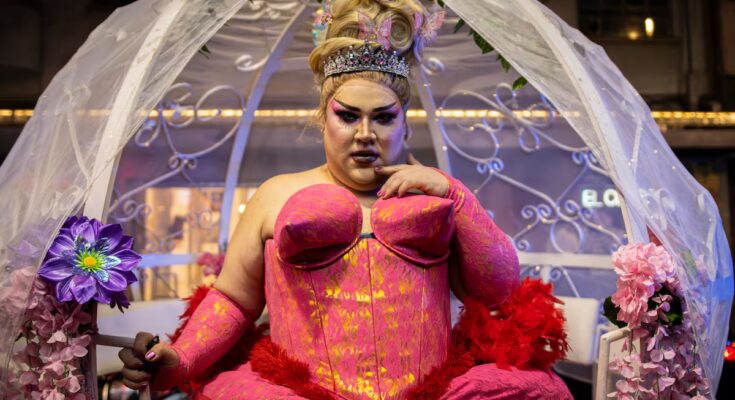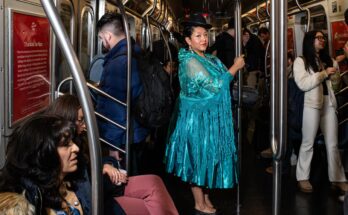Turning 15 is not an easy thing. Ronda Di, the presenter who tonight will mark the passage of a celebration that is seen as a triumph in a continuous fight against the elements and adverse vicissitudes, including pandemics, says it into the microphone. The drag queen, dressed in a pink dress with a tulle skirt, a very tight corset and protruding cones that highlight her chest, promises it will be an epic night at La Purísima, Mexico City’s iconic gay nightclub celebrating three decades transformed into a temple of freedom and resistance for the LGBT community. “In Mexico we live in a very sexist and very repressed country; maybe that’s not possible at home note down or you pick up the pen and this is a safe place where you can do it knowing that no one is going to judge you or disrespect you,” Ronda says.
The celebration begins the moment she, with a bottle of tequila in hand, takes her first drink. “You’ll see what a mess we’ll make,” he promises on a platform decorated in the traditional style of Mexican quinceañeras: hundreds of plastic roses, gold balloons and lots of feathers and sequins. In one corner, the party is animated by Marisol Mendoza, better known as the Great Muse, known, heir to a “dynasty” of sonideros from the neighborhood of Tacuba, in the west of the capital, who will play the vinyl so that her hips move to the rhythm of the cumbia, salsa, guarache or merengue that she has prepared this evening.
A night that promises to be a celebration in which biblical will will be put to the test, because La Puri – as its parishioners call it – is decorated like a Catholic temple. Here there are saints who kiss, crucified Christs who guard the bar well stocked with liquor, virgins with mystical gazes, priests who suck candles as if they were performing a Fellatio and at the center of everything, the main altar, the “Santa Verga” elevated between Doric columns, an enormous phallus to which two priests pay blissful devotion.
A beautiful provocation, but also a declaration of intent in a deeply Catholic country, where until recently so-called conversion therapies were not punished. A recent reform of the penal code has classified them as a crime. Furthermore, crimes against this community persist in Mexico. A third of Mexicans have witnessed acts of violence against this group and data from the National Observatory on Hate Crimes against LGTB people show that between 2014 and until June 2025, at least 739 cases of murders and disappearances of people of sexual diversity were recorded.
That’s why Ronda feels safe here. “I have been a customer of La Puri for 10 years, before I became a drag queen,” he explains. “I came as a boy and it was here that I started to find myself and explore my feminine side. I loved this place for the freedom I saw, because 10 years ago in other places, even in LGBT clubs, they didn’t let trans girls or drag girls in. I think this was the first place that gave us refuge in the whole city. Here I felt protected,” she says.
La Purísima opened its doors thanks to the impetus of Juan Carlos Bautista and Víctor Jaramillo, activists of the LGBT movement. “Pioneers of the first Pride marches”, underlines Arturo Elías Álvarez, owner of the place and nephew of the founders. The uncles had opened another iconic venue, El Marraquech, because, says Álvarez, they had always dreamed as a couple of having a gay cantina. “Then they warmed up and staged La Puri, which is a democratic party, because you can come as a journalist and dance with a waiter, a bricklayer. On the dance floor those boundaries are broken down, which are nonsense and here it is very clear”, he explains.
The person who has accompanied La Puri since her debut is Ernesto Hilario, dressed tonight in Elton John style, huge glasses, embroidered jacket, rings and the typical square haircut that frames the face with its brown color. “Víctor Jaramillo, who studied with me at UNAM, loved Chavela Vargas and everything that smells of Mexico in dance, in food, in music. He thought of something like raising his voice out loud and created La Purísima. He had very clear ideas. He read a lot, he liked cinema, art. And he decided to combine all this with the worldview of Mexico, to create La Puri as an alternative of cultured and musical entertainment, where diversity and sexual freedoms are respected. “Everyone, heterosexual, gay, trans. It’s a wonderful place,” he says, as he kisses a friend on the cheek, a young man dressed cowboy-style, with a large black-brimmed hat, tight jeans, but covered in a faux fur shawl.
It was no easy task to maintain this place, says its current owner. In a constantly changing city, struggling with the tension of gentrification and the emergence of recreational spots that turn their backs on the old and beautiful center of the capital to move the chilanga scene to trendier neighborhoods like Roma or Condesa, La Puri has managed to weather strong waves. “It’s a lot of effort,” says Álvarez. “But also a lot of excitement to see how we are adapting to the future, because everything changes. The current generation drinks less than the previous one, for example. And in the beginning it was a 100% LGBT place, it was rare to see a heterosexual here, but now it’s a very mixed place. I think even heterosexuals have lost their fear, the taboos have been broken down and this place is a window to see that,” he explains.

One of the most difficult moments for this club – as they call nightclubs in Mexico – was the blow of the Covid-19 pandemic and the long confinement that devastated hundreds of businesses in the capital. “We survive by spending our savings and borrowing money,” he confesses. “Because we were paying salaries, because we thought it was going to be something short. Then it hit us all in the tower,” he says. It was many efforts and perhaps divine intervention on the part of the gay saints who populate the place, that kept this establishment from closing. Together, obviously, with the faith of his parishioners.
And customers like Irene and Monse, a couple who enjoy the night accompanied by gin and tonic. “This is my place of freedom,” declares Irene, 30, who has been visiting La Puri since 2017. “It is a place of celebration and unity, where we can have fun without danger, because since I met her, I have loved the atmosphere, I have felt at home and, moreover, I feel safe,” she says. An important issue, that of safety, in a country that kills 10 women a day. “Puri is something that everyone should do at least once, both as tourists and as us who live here, because it is something else, it is more,” he says. Monse nods next to him. “I love it,” the young woman says. “I go there more and more,” he says. The couple kisses while a cumbia seems ready to blast the speakers.

When the middle of the evening arrives, sonidera Mendoza, the Great Muse, stops the music. It’s time for the traditional 15th birthday waltz. Ronda Di makes room with her cone breasts and occupies the center of the field. A waltz sounds in the mouth of the Puerto Rican Chayanne, because here kitsch, underground and an idea of identity mark the atmosphere. Later it will be the turn of Adele, another drag queen who imitates the English with her famous, cheesy and sticky Rolling in The Deep, and a technoband band from northern Mexico. But first, Mexican publisher Guillermo Osorno will replace the Great Muse on the turntable. After the speeches and the waltz it is time for madness, wild dancing, kisses on the dance floor, religious dedication to a festive pandemonium. It’s the fifteenth party at La Puri, the gay temple in Mexico City. “This is a place of resistance,” says Ronda Di. “We’re going to have an epic night,” he promises.



